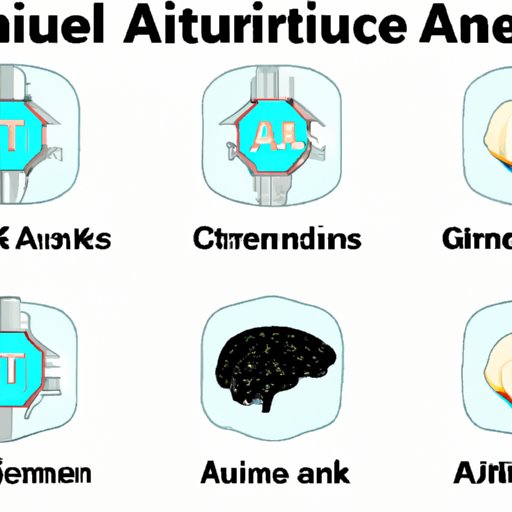Introduction
Artificial Intelligence (AI) is a rapidly advancing field of technology that is transforming the way we live and interact with machines. AI has the potential to revolutionize the way humans interact with computers, making them more intelligent, intuitive, and powerful. In this article, we will explore the different types of AI and their implications for our lives.
A Comprehensive Guide to the Different Types of Artificial Intelligence
At its most basic level, AI can be divided into four main categories: machine learning, natural language processing, computer vision, and robotics. Each of these categories can be further broken down into subcategories, which we’ll explore in more detail below.
Machine Learning
Machine learning is a subset of AI that focuses on giving computers the ability to learn without being explicitly programmed. It uses algorithms to process data and make predictions or decisions based on that data. Machine learning algorithms can be supervised or unsupervised, meaning they can either be trained using labeled data or left to discover patterns in data on their own.
Natural Language Processing
Natural language processing (NLP) is a branch of artificial intelligence that focuses on enabling computers to understand and generate human language. NLP systems use algorithms to analyze text and speech and extract meaningful information from it. This allows them to understand commands, answer questions, and even generate new content.
Computer Vision
Computer vision is a branch of AI that deals with giving computers the ability to see and interpret visual information. It uses algorithms to process images and videos and extract useful information from them. This can be used for facial recognition, object detection, and even autonomous vehicle navigation.
Robotics
Robotics is a branch of AI that deals with building and programming robots. These robots have the ability to perceive their environment, make decisions, and take action accordingly. They are used in many industries, from manufacturing to healthcare, to automate tasks that would otherwise be done by humans.

Exploring the Many Facets of Artificial Intelligence: An Overview of AI Types
In addition to the four main categories of AI mentioned above, there are several other types of AI that can be categorized according to their approach or application. These include supervised learning, unsupervised learning, reinforcement learning, symbolic AI, neural networks, evolutionary computing, autonomous agents, fuzzy logic, and expert systems.
Supervised Learning
Supervised learning is a type of machine learning where algorithms are trained using labeled data. The algorithm is given examples of inputs and the desired output, and it uses this data to learn how to map inputs to outputs. This approach is often used for tasks such as image classification and object detection.
Unsupervised Learning
Unsupervised learning is a type of machine learning where algorithms are trained using unlabeled data. The algorithms are left to discover patterns in the data on their own. This approach is often used for tasks such as clustering and recommendation systems.
Reinforcement Learning
Reinforcement learning is a type of machine learning where algorithms are trained using rewards and punishments. The algorithm is given a goal and it learns to achieve that goal by trial and error. This approach is often used for tasks such as playing games and controlling robots.
The Pros and Cons of Different Types of Artificial Intelligence
As with any technology, there are both advantages and disadvantages to using AI. On the one hand, AI can help automate tedious tasks, reduce human error, and save time and money. On the other hand, AI can be expensive to implement and maintain, and there are concerns about privacy and security.
Advantages of AI
One of the primary advantages of AI is its ability to automate tedious tasks. By using AI, businesses can save time and money on mundane activities such as data entry and customer service. AI can also help improve accuracy by reducing human error. In addition, AI can help businesses gain insights into customer behavior and preferences, allowing them to better target their products and services.
Disadvantages of AI
One of the biggest disadvantages of AI is the cost of implementation and maintenance. AI systems require specialized hardware and software, and they often require significant amounts of data to train and operate. In addition, there are concerns about privacy and security, as AI systems can become vulnerable to hacking and manipulation.

Understanding the Different Forms of Artificial Intelligence
In addition to the types of AI mentioned above, there are several other forms of AI that are used in various applications. These include symbolic AI, neural networks, evolutionary computing, autonomous agents, fuzzy logic, and expert systems.
Symbolic AI
Symbolic AI is a form of AI that focuses on using symbols and logical rules to solve problems. It is commonly used for tasks such as game playing, decision-making, and natural language understanding. Symbolic AI systems are able to reason and draw conclusions based on the data they are given.
Neural Networks
Neural networks are a type of AI that is inspired by the structure and functioning of the human brain. They are composed of interconnected “neurons” that can process information and learn from data. Neural networks are often used for tasks such as image recognition, language translation, and stock market prediction.
Evolutionary Computing
Evolutionary computing is a form of AI that uses evolutionary algorithms to solve problems. These algorithms are inspired by the process of natural selection, where solutions are selected based on their “fitness”. Evolutionary computing is often used for optimization and search tasks, such as finding the shortest path between two points.
A Closer Look at the Various Types of Artificial Intelligence
In addition to the forms of AI mentioned above, there are several other types of AI that are used in various applications. These include autonomous agents, fuzzy logic, and expert systems.
Autonomous Agents
Autonomous agents are AI systems that are able to sense their environment and act independently. These systems are often used for tasks such as search and rescue, autonomous vehicles, and home automation. Autonomous agents can be programmed to make decisions based on their environment and the data they receive.
Fuzzy Logic
Fuzzy logic is a form of AI that deals with uncertainty. It uses mathematical models to represent imprecise data and draw conclusions from it. Fuzzy logic is often used for tasks such as decision-making, control systems, and natural language understanding.
Expert Systems
Expert systems are AI systems that are designed to mimic the behavior of human experts. They are composed of a knowledge base of facts and rules, and they use this knowledge to make decisions and solve problems. Expert systems are often used in medical diagnosis, legal advice, and financial planning.

Exploring the Different Kinds of Artificial Intelligence Technologies
In addition to the types of AI mentioned above, there are several other forms of AI technology that are being developed. These include cognitive computing, intelligent agents, and robotic process automation.
Cognitive Computing
Cognitive computing is a type of AI that focuses on simulating human thought processes. It uses natural language processing and machine learning algorithms to understand and respond to questions. Cognitive computing systems are often used for tasks such as automated customer service, natural language generation, and image recognition.
Intelligent Agents
Intelligent agents are AI systems that are able to autonomously interact with their environment. These systems can be programmed to sense, plan, and act according to the data they receive. Intelligent agents are often used for tasks such as search and rescue, autonomous driving, and home automation.
Robotic Process Automation
Robotic process automation (RPA) is a type of AI that is used to automate repetitive tasks. RPA systems can be programmed to perform mundane tasks such as data entry, customer service, and invoice processing. This can help businesses save time and money while improving accuracy and efficiency.
Conclusion
In conclusion, there are many different types of AI that are being used in various applications. From machine learning to expert systems, AI is transforming the way we live and interact with machines. As AI continues to advance, it will open up new possibilities for businesses, governments, and individuals alike.
(Note: Is this article not meeting your expectations? Do you have knowledge or insights to share? Unlock new opportunities and expand your reach by joining our authors team. Click Registration to join us and share your expertise with our readers.)
